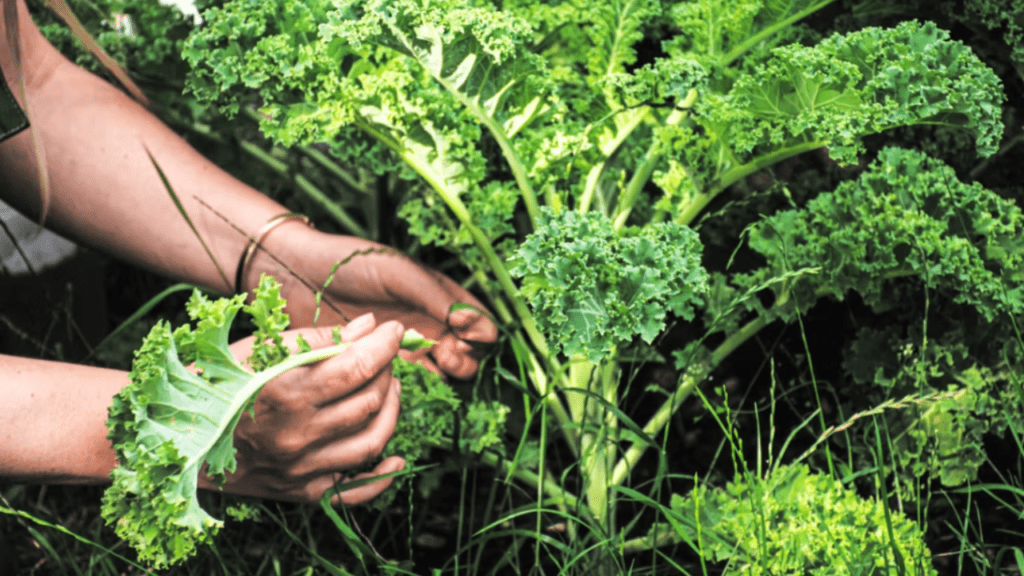
How to Harvest Kale: Essential Tips for Beginners
Kale is a nutritious and versatile leafy green that thrives in a variety of climates. Knowing how to harvest kale properly is essential to ensure you get the most out of your garden. In this guide, we’ll walk you through the best practices for harvesting kale, including timing, techniques, and tips for maintaining the quality of your greens.
Table of Contents
ToggleUnderstanding Kale Growth
Kale Varieties
Overview of different types of kale (curly, lacinato, etc.)
Now, let’s talk about the different types of kale. There are several varieties of kale, each with its own unique characteristics and flavors. The most common types of kale are curly kale, lacinato kale (also known as dinosaur kale), and red Russian kale. Curly kale has a ruffled appearance and a slightly peppery flavor, while lacinato kale has a dark, bumpy texture and a slightly sweeter taste. Red Russian kale has purple stems and a mild, sweet flavor. Each variety of kale can be used in a variety of dishes, from salads to smoothies to soups.
When it comes to harvesting kale, it’s important to wait until the leaves are mature before picking them. This will ensure that the kale is at its peak flavor and nutritional content. To harvest kale, simply use a sharp pair of scissors or garden shears to cut the leaves from the main stem, leaving at least two to three inches of stem to encourage regrowth. Be sure to harvest the outer leaves first, allowing the inner leaves to continue growing and prolonging the harvest season.
In conclusion, understanding the different types of kale and how to properly harvest it is essential for anyone looking to cultivate this nutritious and delicious leafy green. Whether you’re a seasoned gardener or a beginner, incorporating kale into your garden can be a rewarding and enjoyable experience. So go ahead, plant some kale and enjoy the bountiful harvest that will follow!
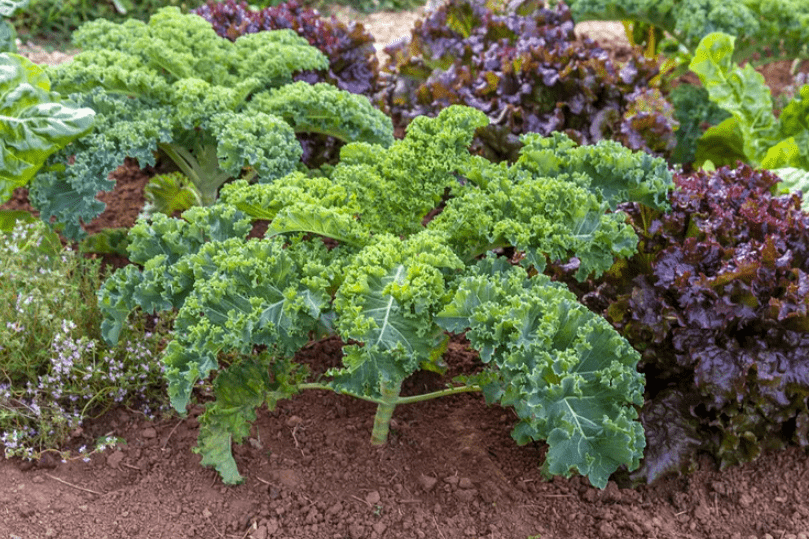
How each variety affects the harvesting process.
There are several varieties of kale, each with its own unique characteristics that can affect the harvesting process. For example, curly kale tends to have a more robust flavor and is often used in soups and stews, while lacinato kale, also known as dinosaur kale, has a sweeter taste and is great for salads and smoothies. Red Russian kale is known for its tender leaves and is perfect for sautéing or steaming. When it comes to harvesting kale, it’s important to wait until the leaves are mature before picking them. This will ensure that the kale is at its peak flavor and nutritional content. To harvest kale, simply use a sharp pair of scissors or garden shears to cut the leaves from the main stem, leaving at least two to three inches of stem to encourage regrowth. Be sure to harvest the outer leaves first, allowing the inner leaves to continue growing and prolonging the harvest season. In conclusion, understanding the different types of kale and how to properly harvest it is essential for anyone looking to cultivate this nutritious and delicious leafy green. Whether you’re a seasoned gardener or a beginner, incorporating kale into your garden can be a rewarding and enjoyable experience. So go ahead, plant some kale and enjoy the bountiful harvest that will follow!
Growth Stages
Description of kale’s growth cycle from planting to harvest.
Kale is a hearty, leafy green that can thrive in a variety of growing conditions. When planting kale, it’s important to choose a location with well-drained soil and full sun. Start by planting the seeds or seedlings in the spring or fall, depending on your climate. Once planted, kale will begin to grow and develop a strong root system. As the plant matures, it will produce large, vibrant leaves that are ready for harvest. It’s important to wait until the leaves are mature before picking them, as this will ensure that the kale is at its peak flavor and nutritional content. To harvest kale, simply use a sharp pair of scissors or garden shears to cut the leaves from the main stem, leaving at least two to three inches of stem to encourage regrowth. Be sure to harvest the outer leaves first, allowing the inner leaves to continue growing and prolonging the harvest season. With proper care and attention, kale can provide a bountiful harvest throughout the growing season. So, if you’re looking to add a nutritious and delicious green to your garden, consider planting kale and enjoy the process of watching it grow and flourish.
Key indicators that kale is ready to be harvested.
Kale is a fantastic and nutritious addition to any garden, and knowing when it’s ready to be harvested is crucial for getting the best flavor and nutrients. One key indicator that kale is ready to be harvested is when the leaves are large and vibrant in color. As the plant matures, the leaves will become more substantial and have a rich, deep green hue. It’s important to wait until the leaves are fully developed before picking them, as this will ensure that you’re getting the most out of your kale. Additionally, you can check the stem of the plant to see if it’s thick and sturdy, which is another sign that the kale is ready to be harvested. When you’re ready to pick your kale, simply use a pair of scissors or garden shears to cut the leaves from the main stem, leaving a few inches of stem to encourage regrowth. By harvesting the outer leaves first and allowing the inner leaves to continue growing, you can prolong the harvest season and enjoy a continuous supply of fresh kale. So, keep an eye on these key indicators and enjoy the bountiful harvest of your homegrown kale.
When to Harvest Kale
Optimal Harvesting Time
Best time to harvest for tender leaves vs. mature leaves.
The best time to harvest kale for tender leaves is when the plant is still young and the leaves are small and tender. These young leaves are perfect for salads and smoothies, as they are more delicate and have a milder taste. On the other hand, if you prefer a heartier, more robust flavor, then you should wait until the kale leaves have fully matured. As the plant matures, the leaves will become more substantial and have a rich, deep green hue. It’s important to wait until the leaves are fully developed before picking them, as this will ensure that you’re getting the most out of your kale. Additionally, you can check the stem of the plant to see if it’s thick and sturdy, which is another sign that the kale is ready to be harvested. When you’re ready to pick your kale, simply use a pair of scissors or garden shears to cut the leaves from the main stem, leaving a few inches of stem to encourage regrowth. By harvesting the outer leaves first and allowing the inner leaves to continue growing, you can prolong the harvest season and enjoy a continuous supply of fresh kale. So, keep an eye on these key indicators and enjoy the bountiful harvest of your homegrown kale.
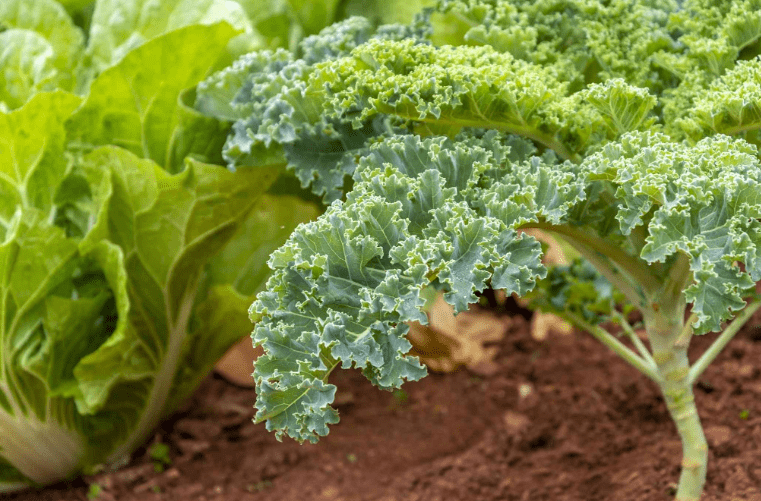
Seasonal considerations (e.g., harvesting after frost).
When it comes to harvesting kale, timing is key. If you want a milder, sweeter flavor, consider picking your kale after the first frost. The cold weather actually helps to break down the starches in the plant, resulting in a sweeter taste. This is a great option for those who prefer a more delicate flavor profile in their kale. Additionally, waiting until after the frost can also enhance the color of the leaves, giving them a vibrant, deep green color that is visually appealing. This is a great way to take advantage of the changing seasons and get the most out of your kale harvest. By waiting for the right time to harvest, you can ensure that you’re getting the best flavor and quality from your kale. So be patient and wait for the perfect moment to pick your kale. It’s worth it for the delicious, nutrient-rich leaves that you’ll get to enjoy. Consider the seasonal factors and make the most of your kale harvest.
Signs of Readiness
Visual and physical signs that kale is ready for harvest.
When it comes to harvesting kale, there are a few important signs to look for to determine if it’s ready. One visual sign to look for is the size of the leaves. Mature kale leaves are typically around 6-8 inches long, so if your kale leaves have reached this size, they are likely ready to be harvested. Another visual sign is the color of the leaves. If the leaves are a vibrant, deep green color, it’s a good indication that they are ready to be picked. In terms of physical signs, you can gently tug on a leaf and if it comes off easily, then it’s likely ready for harvest. Additionally, waiting until after the first frost can enhance the flavor and color of the leaves, so keep an eye out for this seasonal change before picking your kale. By paying attention to these signs, you can ensure that you’re harvesting your kale at the perfect time for the best flavor and quality. So be patient and observant, and enjoy the delicious, nutrient-rich harvest that comes from waiting for the right moment to pick your kale.
Importance of harvesting at the right stage for flavor and texture.
Harvesting your kale at the right stage is crucial for ensuring that it has the best flavor and texture. Mature kale leaves are typically around 6-8 inches long, and if your kale leaves have reached this size, they are likely ready to be harvested. Another visual sign is the color of the leaves. If the leaves are a vibrant, deep green color, it’s a good indication that they are ready to be picked. In terms of physical signs, you can gently tug on a leaf and if it comes off easily, then it’s likely ready for harvest. Additionally, waiting until after the first frost can enhance the flavor and color of the leaves, so keep an eye out for this seasonal change before picking your kale.
By paying attention to these signs, you can ensure that you’re harvesting your kale at the perfect time for the best flavor and quality. So be patient and observant, and enjoy the delicious, nutrient-rich harvest that comes from waiting for the right moment to pick your kale. Don’t rush the process; the results will be worth it. Your taste buds and your body will thank you for taking the time to harvest your kale at the peak of perfection. Enjoy the fresh, vibrant flavors and textures that come from waiting for the perfect moment to harvest.
How to Harvest Kale
Tools and Equipment
Necessary tools (scissors, shears, etc.) and their importance.
When it comes to harvesting kale, having the right tools is essential. Scissors or shears are necessary for cleanly cutting the leaves from the plant without damaging the rest of the plant. They provide a sharp, precise cut that helps to maintain the overall health of the kale plant. Using the proper tools also makes the harvesting process quicker and more efficient, saving you time and effort in the long run. Additionally, having the right tools ensures that you can harvest your kale at the perfect time, allowing you to enjoy the best flavor and nutritional value. Don’t underestimate the importance of having the right tools for the job – they can make all the difference in the quality of your harvest. So, make sure you have the necessary tools and equipment on hand and take the time to harvest your kale properly. Your efforts will be rewarded with delicious, nutrient-rich kale that you can enjoy and share with others.
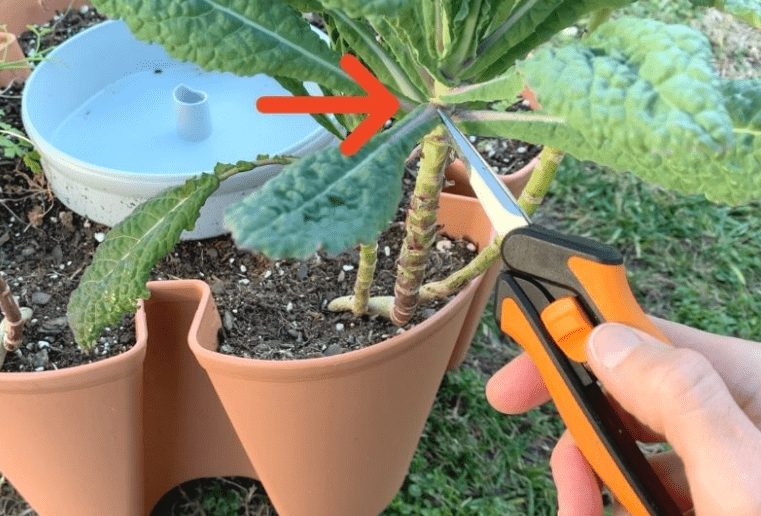
Harvesting Techniques
Step-by-step guide to harvesting kale leaves.
Harvesting kale leaves can be a simple and rewarding process when done properly. To start, you’ll need a pair of sharp scissors or shears to cleanly cut the leaves from the plant without causing any damage. Using the right tools is essential for maintaining the overall health of the kale plant and ensuring a quick and efficient harvesting process. With the proper tools, you can also ensure that you’re harvesting your kale at the optimal time, when the leaves are at their peak flavor and nutritional value. It’s important to have the right equipment on hand to make the most of your harvest. So, take the time to gather the necessary tools and follow these step-by-step techniques for a successful kale harvest. First, identify which leaves are ready for harvesting. Look for mature leaves that are large and vibrant in color. Using your scissors or shears, carefully cut the leaves from the stem, leaving behind the smaller, inner leaves to continue growing. Be sure to avoid damaging the rest of the plant as you harvest. Once you’ve collected your kale leaves, give them a good rinse and pat them dry before enjoying them in your favorite dishes. By following these harvesting techniques, you can ensure that you’re getting the most out of your kale crop and enjoying delicious, nutrient-rich leaves that you can share with others.
Tips for cutting and handling leaves to avoid plant damage.
When it comes to harvesting leaves from your plants, it’s important to take the time to do it right in order to avoid damaging the plant. First, make sure to identify which leaves are ready for harvesting. Look for mature leaves that are large and vibrant in color. Using a sharp pair of scissors or shears, carefully cut the leaves from the stem, leaving behind the smaller, inner leaves to continue growing. Be sure to avoid damaging the rest of the plant as you harvest.
Once you’ve collected your kale leaves, give them a good rinse and pat them dry before enjoying them in your favorite dishes. By following these harvesting techniques, you can ensure that you’re getting the most out of your kale crop and enjoying delicious, nutrient-rich leaves that you can share with others. Taking the time to handle your plants with care will result in a bountiful and healthy harvest, so be sure to use these tips when cutting and handling leaves to avoid plant damage.
Post-Harvest Handling
Cleaning and drying kale leaves.
When it comes to harvesting and handling kale leaves, it’s crucial to do it with care in order to preserve the quality and flavor of the leaves. After harvesting, it’s important to clean the leaves thoroughly to remove any dirt or residue. Rinse the leaves under cold water and gently pat them dry with a clean towel or paper towel. This will help to remove any excess moisture and prevent the leaves from becoming soggy.
Once the leaves are clean and dry, store them in a breathable container or bag in the refrigerator to keep them fresh for longer. Avoid washing the leaves until you are ready to use them, as excess moisture can cause them to spoil more quickly. By taking the time to properly clean and dry your kale leaves, you can ensure that they remain fresh and flavorful, ready to be enjoyed in a variety of dishes. Taking these simple steps can make a big difference in the quality of your harvest and the enjoyment of your kale leaves.
Storage tips to maintain freshness and quality.
Proper storage is essential for maintaining the freshness and quality of your produce. After harvesting, it’s important to clean the leaves thoroughly to remove any dirt or residue. This simple step can make a big difference in the quality of your kale leaves. Once the leaves are clean and dry, store them in a breathable container or bag in the refrigerator to keep them fresh for longer. Avoid washing the leaves until you are ready to use them, as excess moisture can cause them to spoil more quickly. By taking the time to properly clean and dry your kale leaves, you can ensure that they remain fresh and flavorful, ready to be enjoyed in a variety of dishes. Don’t let your hard work in growing and harvesting your produce go to waste – take the necessary steps to store it properly and enjoy it for as long as possible.
Common Mistakes to Avoid
Early or Late Harvesting
Consequences of harvesting too early or too late.
Harvesting your produce at the right time is crucial to ensure optimal flavor and nutritional value. If you harvest too early, the produce may not have fully developed its flavor and nutrients, leading to a less satisfying eating experience. On the other hand, if you harvest too late, the produce may become overripe, leading to a loss of flavor and texture. It’s important to pay attention to the specific harvest time for each type of produce to ensure that you are getting the most out of your efforts. By harvesting at the right time, you can enjoy the full benefits of your hard work and have the best possible eating experience. So, take the time to learn about the proper harvest times for your produce and avoid the consequences of harvesting too early or too late. Your taste buds and your body will thank you for it.
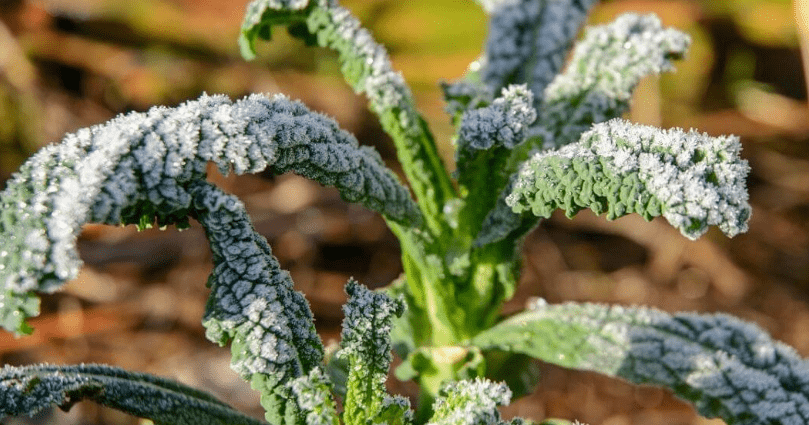
Overharvesting
Risks and solutions to prevent overharvesting.
Overharvesting is a serious issue that can have detrimental effects on the environment and the sustainability of our food sources. When we overharvest, we deplete the natural resources and disrupt the balance of ecosystems. This can lead to a decrease in biodiversity and the extinction of certain species. To prevent overharvesting, we need to implement sustainable harvesting practices and be mindful of the impact our actions have on the environment. This can include setting quotas for harvesting, implementing regulations to protect certain species, and promoting responsible and ethical harvesting practices. By taking these steps, we can ensure that we can continue to enjoy the abundance of nature’s bounty for generations to come. It’s important to be conscious of the potential risks of overharvesting and take proactive measures to prevent it. We all have a responsibility to protect our natural resources and preserve the balance of ecosystems for the benefit of future generations. Let’s work together to prevent overharvesting and ensure a sustainable future for all.
Neglecting Plant Health
How poor plant care can affect harvesting and overall yield.
Neglecting plant care can have a detrimental impact on harvesting and overall yield. When plants are not properly cared for, they are more susceptible to disease, pests, and other environmental factors that can reduce their productivity. This can lead to a decrease in biodiversity and the extinction of certain species, which in turn disrupts the delicate balance of our ecosystems. To prevent overharvesting, we need to implement sustainable harvesting practices and be mindful of the impact our actions have on the environment. It’s important to set quotas for harvesting, implement regulations to protect certain species, and promote responsible and ethical harvesting practices. By taking these steps, we can ensure that we can continue to enjoy the abundance of nature’s bounty for generations to come. We all have a responsibility to protect our natural resources and preserve the balance of ecosystems for the benefit of future generations. Let’s work together to prevent overharvesting and ensure a sustainable future for all.
Additional Tips and Tricks
Enhancing Flavor
Tips for improving the taste and quality of kale.
Kale is a superfood that is not only nutritious but can also taste delicious if prepared properly. To enhance the flavor and quality of kale, there are a few tips and tricks you can follow. First, make sure to properly wash and dry the kale leaves before using them. This will help remove any dirt or residue and ensure a clean taste. Additionally, consider massaging the kale leaves with a bit of olive oil and salt before cooking or eating raw. This can help to break down the tough fibers and make the kale more tender and flavorful. Adding in some acidic ingredients like lemon juice or vinegar can also help to balance out the bitterness of kale and add a bright and tangy flavor. Lastly, don’t be afraid to experiment with different cooking methods such as roasting, sautéing, or even making kale chips for a fun and tasty snack. By following these tips, you can elevate the taste and quality of kale and enjoy all the amazing health benefits it has to offer. So go ahead and give kale a try, and experience the deliciousness and nutrition it has to offer.
Creative Uses for Kale
Ideas for using harvested kale in recipes and dishes.
Kale is a versatile and nutritious vegetable that can be used in a variety of recipes and dishes. One great way to prepare kale is to start by washing it thoroughly. This will help remove any dirt or residue and ensure a clean taste. Additionally, consider massaging the kale leaves with a bit of olive oil and salt before cooking or eating raw. This can help to break down the tough fibers and make the kale more tender and flavorful. Adding in some acidic ingredients like lemon juice or vinegar can also help to balance out the bitterness of kale and add a bright and tangy flavor. Lastly, don’t be afraid to experiment with different cooking methods such as roasting, sautéing, or even making kale chips for a fun and tasty snack. By following these tips, you can elevate the taste and quality of kale and enjoy all the amazing health benefits it has to offer. So go ahead and give kale a try, and experience the deliciousness and nutrition it has to offer.
In conclusion, harvesting kale may seem like a simple task, but there are certain techniques and tips that can make the process much more efficient and effective. By following the advice in this post, you can ensure that you are harvesting your kale in the best possible way, leading to a bountiful and delicious harvest. So, next time you’re ready to harvest your kale, remember these essential tips and watch your garden flourish with healthy, vibrant greens. Happy harvesting!
Frequently asked questions And Answer
The best time to harvest kale is in the morning when the leaves are crisp and full of nutrients. It’s also best to harvest before the plant starts to flower, as the leaves can become bitter after flowering.
To harvest kale, simply use a sharp knife or scissors to cut the outer leaves, leaving the inner leaves to continue growing. Make sure to cut the leaves at the base, close to the stem, to encourage new growth.
While you can harvest the entire plant at once, it’s best to only take a few leaves from each plant at a time to allow for continuous growth. This will ensure a longer harvest period.
When harvesting kale, look for leaves that are dark green and firm, with no signs of wilting or yellowing. Avoid harvesting leaves that are damaged or discolored.
After harvesting, it’s best to wash the leaves and dry them thoroughly before storing them in a plastic bag in the refrigerator. This will help to keep the kale fresh for longer.
Kale is a cold-hardy vegetable and can be harvested well into the winter months, even after a light frost. In fact, some people find that the flavor of kale improves after being exposed to cooler temperatures.
One common mistake is harvesting the entire plant at once, which can limit the plant’s regrowth. It’s also important to avoid damaging the plant while harvesting, as this can hinder future growth.
It’s important to regularly harvest kale to encourage new growth and prevent the plant from becoming too woody. Additionally, be sure to remove any yellow or brown leaves to keep the plant healthy. Happy harvesting!
